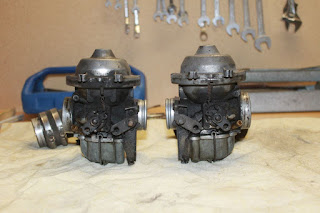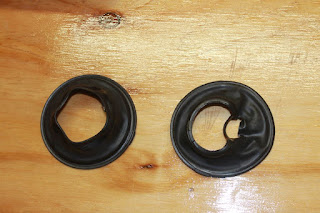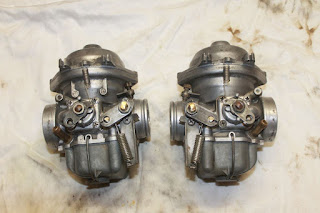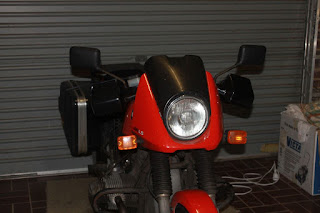BMW manufactured the R65LS from 1981 to 1985 in two colours, henna red and polaris silver, and two delivery markets, EUR and USA. Some modifications were made for different delivery countries, these are listed as "national version" on RealOEM. There were a plethora of variations on these two themes some of which suggest that the bikes were completed from a spare parts bin.
Carburettor. The Haynes manual lists minor variations in the carburettor jetting between UK and US models and between 1982 and subsequent production years. Particularly, there are 4 main jet sizes in these combinations.
Dashboard. Some bikes have "TURN" stamped in the centre of the green dashboard indicator lamps.
Decals. Usually the red bikes had a black and white decal and the silver bikes a blue decal. However, some red bikes had blue decals and some silver got the white. The decals were shipped alongside the bike and the dealers attached them prior to sale, so they may have changed decals based on preference.
Engine Number. The 1983 bikes had the first 7 digits of the VIN stamped above the oil dipstick. They also had an engine number stamped on the lower left of the engine, just above the sump, like "12345678 652VB". Later bikes had just the latter. All my bikes have "652VB". According to the local authorities the correct engine number looks like "83409853 652VB" but some rego papers use the 7 digits from the VIN.
First Aid Kit The first aid kit was optional, but where fitted there was a red sticker on the LHS side cover indicating that it was under the seat. Similarly some bikes came with a tyre pump and a security chain that fitted into the frame tube.Front brake callipers. Most bikes had Brembo callipers, but some had ATE. Both had 36mm pistons. Some Brembo callipers had 12mm mounting holes and a "top hat" spacer to shim them to the M10 bolt, others had 10mm holes.
Front brake master cylinder. The shop manual lists both 15mm and 16mm diameter. Both my bikes have 15mm.
Fuel Tap. Most bikes have the delivery horizontal, but some bikes have the delivery straight down. I think that the latter fuel tap type is suited to tanks with a tap on both sides.
Gear Shift. Some bikes had a rubber gaiter on the arm from the gear lever to the gearbox.
Ignition. US delivery bikes had the
headlight always on, so the ignition had only 3 places not 5 as on other
models. They also had a headlight relay setup so that the headlight would
extinguish when the starter was being used, other bikes having no headlight
relay.
Kick Starter. Some bikes had a kick
starter. It seems that this was offered as an option on new bikes.
Handlebars. RealOEM lists the usual small bars and a higher variant, I've not known the high version to have been used on any new bike.
Hazard lights. Some bikes had a
hazard light switch in the centre of the dash.
Reflectors. Some delivery markets had extra reflectors. Particularly, the USA delivery bikes had round red reflectors on the sides of the rear mudguard.
Seat Strap. This is listed as part of the national version for Japan and France on RealOEM, I've never seen one: RealOEM
Secondary Air System. Some US delivery bikes had hardware that reduced pollution by providing fresh air to the exhaust manifold. This system included a pipe from the airbox to the cylinder head, hoses from the vacuum port at the front of the carburettor to the airbox, and some valves inside the airbox.
Sidecovers. Most bikes have black
side covers, but some are painted to match the tank colour. Some of the original silver bikes had silver side covers, but most have unpainted black.
Speedo. (Obviously) Kilometres for Europe and Australia, miles for UK and US. Japanese delivery bikes had a flashing light that illuminated over the national speed limit of 80km/h.
Tappet Covers. Mostly unpainted
(silver) but some bikes have black.
Wheels. These were painted white on red 1982 bikes and silver afterwards. All silver bikes had silver wheels.
Do you know of any other variations?













